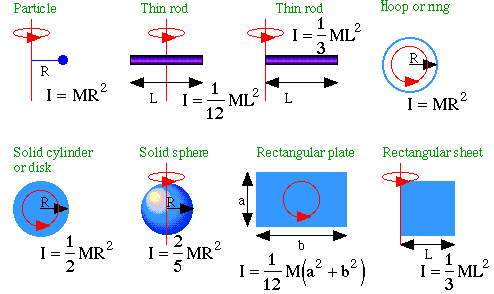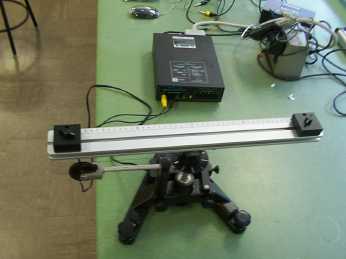
The moment of inertia of an object depends on its shape and the axis of rotation. Some moments of inertia of common objects are shown below. The axis of rotation is indicated by the red straight lines.

All of these moments of inertia can be calculated with the aid of calculus. The procedure involves multi-dimensional integrals. For our purposes, this is a little too involved, and so we just state the results above. These are sufficient to solve all problems that involve the common objects that contain some kinds of symmetry, such as spheres or disks.
Please note one common feature of all of these moments of inertia: They can all be written as
where M is the mass of the object, and R is the radius. c is a constant, a simple number between 0 and 1.
 However,
what do you do when there is no symmetry that you can use to
integrate? You can still measure an object's moment of inertia. For
example, you can use an apparatus like the one shown here. The
principle is rather simple: We hang a known weight from a
string that is wrapped around the base of of the rotation apparatus
on top of the table, on which the object with unknown moment of
inertia is mounted - here an aluminum plate with two black weights attached to it. One
now releases the weight that is attached to the string from rest and
observes the change in the rotation frequency by measuring the
displacement of the weight.
However,
what do you do when there is no symmetry that you can use to
integrate? You can still measure an object's moment of inertia. For
example, you can use an apparatus like the one shown here. The
principle is rather simple: We hang a known weight from a
string that is wrapped around the base of of the rotation apparatus
on top of the table, on which the object with unknown moment of
inertia is mounted - here an aluminum plate with two black weights attached to it. One
now releases the weight that is attached to the string from rest and
observes the change in the rotation frequency by measuring the
displacement of the weight.
© MultiMedia Physics, 1999